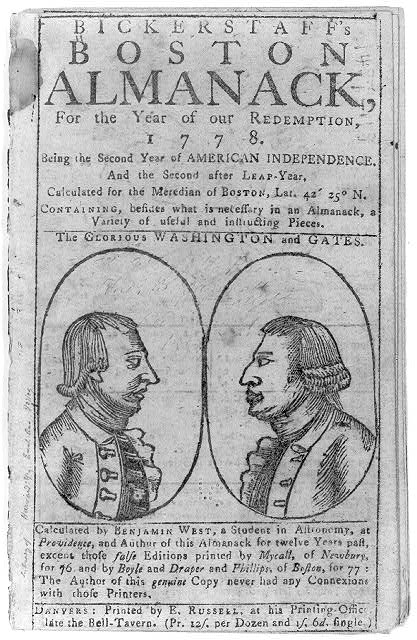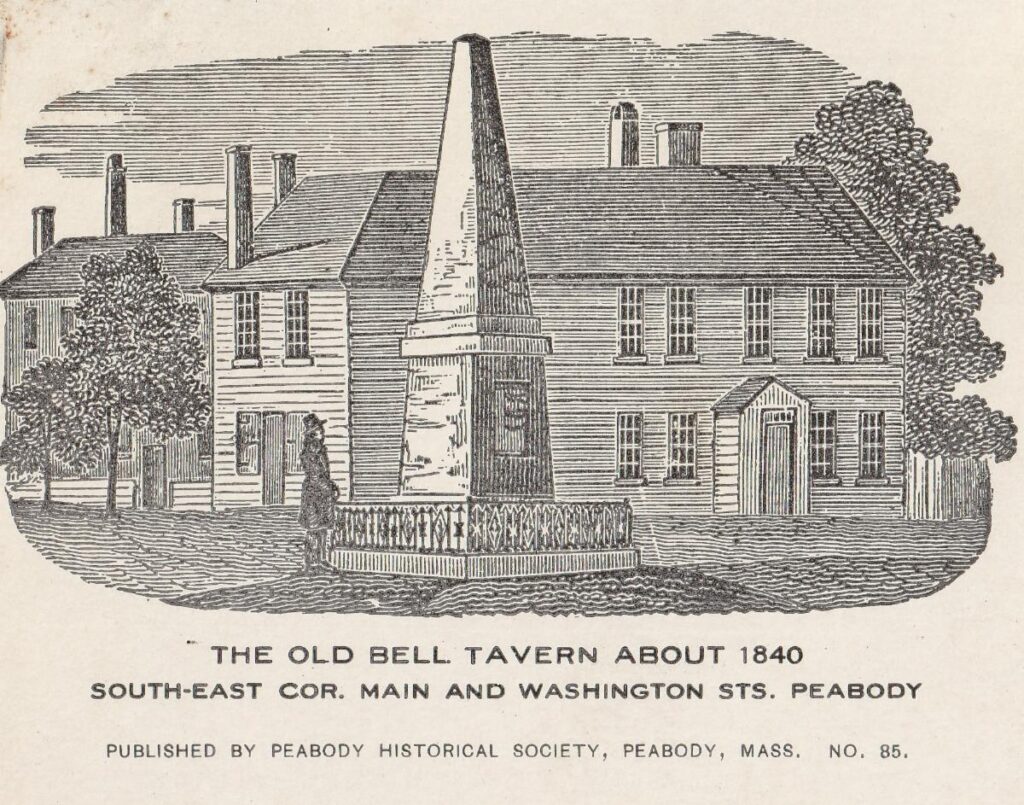With the recent opening of the Bell Inn and Tavern at 2 Washington Street, we wanted to share more about this special corner of Peabody history.

“Eagle Corner and Washington Street” by Charles Dole, 1828.
This 1828 painting has the original Bell Tavern in the background to the far left of the image, with a large directional white pole in front of it, along Main Street. The pole was topped with a golden eagle, giving the area its name “Eagle Corner.”
The original Bell Tavern was built in 1757 by Francis Symonds, who also operated Peabody’s first printing press out of his buildings on Main Street. The Bell Tavern was a place for travelers to stay, eat and drink on their journey.
In 1775, the local militia met in front of the Bell Tavern on April 19th to march to Lexington and Concord. After 4 hours and 16 miles, they reached the village of Menotomy (the city of Arlington today). It was here that the minutemen encountered the retreating British soldiers. These Danvers (now Peabody) men were killed in battle that day: George Southwick, Samuel Cook, Henry Jacobs, Ebenezer Goldthwaite, and Benjamin Daland. The American Revolution began that day, and for these men, their day started at the Bell Tavern. In 1835, the Lexington Monument was built in their memory. The Monument, now moved, stood on Main Street across from the Bell Tavern.

Courtesy of the Library of Congress; Bickerstaff’s Boston Almanack, printed at the Bell Tavern, by E. Russell (Danvers, now Peabody), 1778.

In 1788, only a few years after the American Revolution, the Bell Tavern had one of its most famous and mysterious guests, Elizabeth Whitman. Whitman took a coach from her family’s home in Hartford, Connecticut. She stopped briefly in Watertown and then traveled onto Danvers (now Peabody). She was 37 years old, traveling solo, pregnant and unmarried. In June 1788, she took up residence at the Bell Tavern under the assumed name “Mrs. Walker” and stated that her husband would be joining her in time. He never came.
Elizabeth Whitman died on July 25th, 1788, after having given birth to a stillborn child. Her real name remained a mystery, and town residents took it upon themselves to determine her true identity and provide her with a respectable burial. After her story was published in the local paper, along with a list of her belongings, she was identified.

This wallpaper fragment from the Bell Tavern is believed to be from Elizabeth Whitman’s room; it was removed in 1840 prior to demolition of the Bell Tavern.
Elizabeth Whitman’s place in history was cemented when author Hannah Webster Foster fictionalized her tale in the work The Coquette or, The History of Eliza Wharton, published in 1797. Foster wrote the best-selling novel, changing Whitman’s name to Eliza Wharton, and telling her story in the manner of a cautionary tale to young women about the dangers of following your heart. Hannah Webster Foster is considered one of the first published, female romance novelists in the United States.
The Bell Tavern was demolished in 1840, when it was purchased by the Daniels family. Our next email will finish the story of 2 Washington Street. Stay tuned!
References
“Love, A Touching Episode: Salem Scenes in Eliza Wharton’s Life” The Sunday Boston Herald, August 31, 1902.
Bolton, Charles K. The Elizabeth Whitman mystery at the old Bell tavern in Danvers; a study of “Eliza Wharton,” the heroine of a famous New England romance, Published by the Peabody Historical Society, 1912.
Wells, John. The Peabody Story, Published by the Essex Institute, 1972, pages ages 212-231, 261-264.
Smoller, Sudi. “Eliza Wharton (Elizabeth Whitman)”. Presentation given for Women’s History Month, February 28, 1999.
